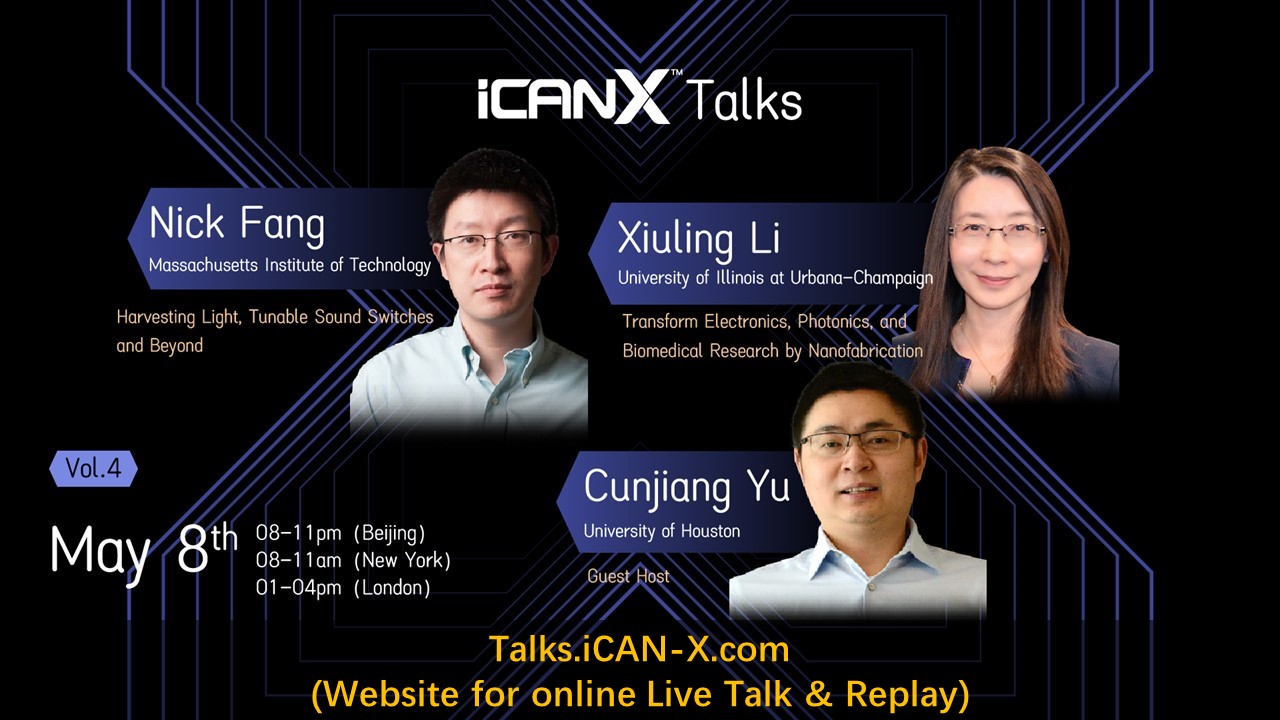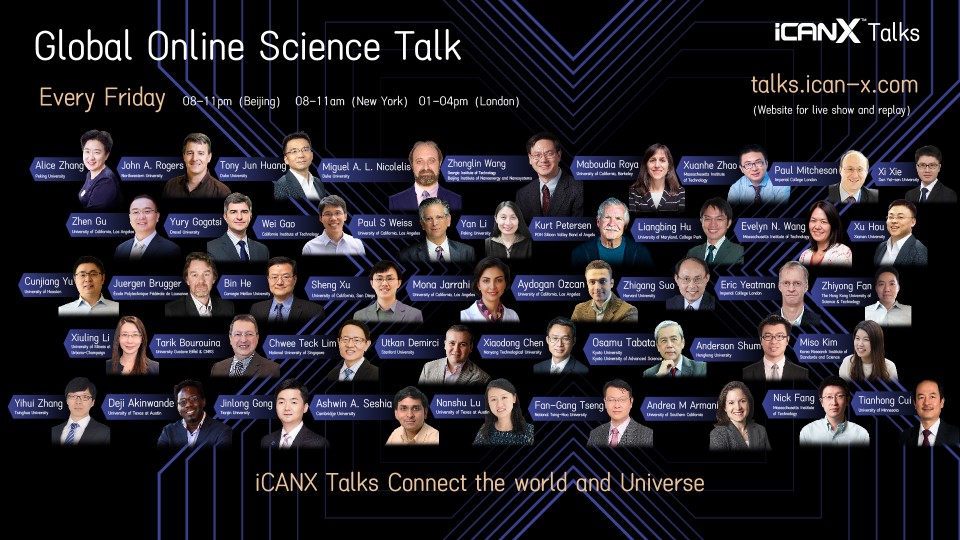博文
MIT&UIUC教授喊你今晚八点来百度听iCANX Talks 直播!
|||
Go to the website for Live Talk & Replay Directly
https://talks.ican-x.com/

今天(5月8日)晚上8点,大家期待已久的第四期 iCANX Talks(全球前沿科技直播)即将来袭,我们为大家邀请到了两位重磅嘉宾,其中一位是美国麻省理工学院 机械工程系方绚莱教授;另一位是伊利诺伊大学厄巴纳-尚佩恩(香槟)分校(UIUC)电气和计算机工程系(ECE)的Donald Biggar Willett教授,及Nick Holonyak Jr.微纳技术实验室的轮值主任 李秀玲教授。
在前三期的iCANX talks直播中,每期吸引专业观众参会突破2万余人,由研究生组成的学术小组整理的学术报告也大受欢迎,形成了极具引力漩涡效应的高科技云端高峰会。
话不多说,先让小艾给大家详细介绍今晚的两位重磅嘉宾及演讲内容吧!
Talk 1
光采集、可调声开关及其他
方绚莱 教授
美国麻省理工学院 机械工程系
课题组网页: http://web.mit.edu/nanophotonics/
 摘 要
摘 要
未来的智能照明和窗口涂层能否为智能建筑带来高能效的制冷?印刷的彩色转换器能否带来具有高亮度、清晰的图像分辨率和超低功耗的下一代微显示器?最近,纳米光学材料的新物理以前所未有的规模激发了一系列对操纵、储存和控制信息和能量流动的关键探索。
在这次演讲中,我将报告我们最近在利用可伸缩的微/纳米结构控制光收集和转换过程方面的努力。这些新兴的光学材料有望应用于一系列重要的领域,从光学网络和芯片级光子传感器,到激光、LED和太阳能技术。例如,我将介绍我们最近的合作成果,通过对对金纳米结构形貌引导应力的研究,实现了纳米尺度结构上通用三维形状的转换。通过形貌导向的应力平衡,精确地实现了丰富的三维形状变换,例如纳米结构的屈曲,旋转和扭曲,并且可以通过我们的机械模型进行预测。得益于纳米级的三维扭转特性,在一个直观设计的三维类风车结构中实现了巨大的光学手性,并与无纳米剪纸(nano-kirigami)结构的非手性二维前驱体形成强烈对比。所展示的纳米剪纸结构以及奇异的三维纳米结构可以应用于广泛的纳米制造平台,并为探索功能性微/纳米光子和机械器件开辟新的可能性。
我还将介绍我们的先进设计和微/纳制造技术的发展,以便能够探索声波的结构化元结构。这些结构显示出通过宽带超材料对超声进行聚焦和重新布线的前景。
简 历
方绚莱教授于南京大学获得物理学学士和硕士学位,其后于加州大学洛杉矶分校获得机械工程博士学位,现任美国麻省理工学院机械工程系教授。在进入麻省理工学院之前,他曾于2004年至2010年在伊利诺伊大学香槟分校担任助理教授。方绚莱教授的研究领域着眼于纳米光子学和纳米制造,获得多项学术荣誉和奖励,包括美国机械工程师协会(ASME) Chao and Trigger Young Manufacturing Engineer 奖 (2013年);国际光学委员会ICO奖(2011年);2010年受邀参加国家科学院工程前沿会议;NSF职业奖(2009年)和麻省理工学院技术评论杂志35位青年创新者奖(2008年)。
Harvesting Light, Tunable Sound Switches and Beyond
Professor Nicholas Xuanlai Fang
Department of Mechanical Engineering, MIT, USA
Group Website: http://web.mit.edu/nanophotonics/
ABSRACT
Will future of smart lighting and window coatings enable energy-efficient cooling in smart buildings? Can printed color converters lead to next generation micro displays with high brightness, sharp image resolution, and ultra‐low power consumption? Recently, exciting new physics of nanoscale optical materials has inspired a series of key explorations to manipulate, store and control the flow of information and energy at unprecedented dimensions.
In this talk I will report our recent efforts on controlling light harvesting and conversion process using scalable micro/nanofabrication. These emerging optical materials show promise to a range of important applications, from optical networks and chip-scale photonic sensors to lasers, LEDs, and solar technology. For example, I will introduce our recent collaborative efforts on versatile 3D shape transformations of nanoscale structures by deliberate engineering of the topography-guided stress of gold nanostructures. By using the topography-guided stress equilibrium, rich 3D shape transformation such as buckling, rotation, and twisting of nanostructures is precisely achieved, which can be predicted by our mechanical modeling. Benefiting from the nanoscale 3D twisting features, giant optical chirality is achieved in an intuitively designed 3D pinwheel-like structure, in strong contrast to the achiral 2D precursor without nano-kirigami. The demonstrated nano-kirigami, as well as the exotic 3D nanostructures, could be adopted in broad nanofabrication platforms and could open up new possibilities for the exploration of functional micro-/nanophotonic and mechanical devices.
I will also present our development of advanced design and micro/nanofabrication techniques, to enable exploration architectured meta structures for acoustic waves. These structures show promise on focusing and rerouting ultrasound through broadband metamaterials.
BIOGRAPHY
Nicholas X. Fang received his BS and MS in physics from Nanjing University, and his PhD in mechanical engineering from University of California Los Angeles. He is currently professor of Mechanical Engineering at MIT. Prior to MIT, he worked as an assistant professor at the University of Illinois Urbana-Champaign from 2004 to 2010. Professor Fang’s areas of research look at nanophotonics and nanofabrication. His recognitions include the ASME Chao and Trigger Young Manufacturing Engineer Award (2013); the ICO prize from the International Commission of Optics (2011); an invited participant of the Frontiers of Engineering Conference by National Academies in 2010; the NSF CAREER Award (2009) and MIT Technology Review Magazine’s 35 Young Innovators Award (2008).
Talk 2
基于纳米制造的转化电子学、光子学和生物医药研究
李秀玲 教授
伊利诺尹大学厄巴纳-尚佩恩(香槟)分校
课题组网站:http://mocvd.ece.illinois.edu
摘 要
我们团队的主要研究领域是半导体材料和器件以及电磁学方向。我们专注于通过自下而上的生长和自上而下的加工来开发新型的结构和器件,从而给电子、光子学和量子技术,乃至于医学领域带来持久的影响。
在本次演讲中,我将介绍我们新近创新的两种纳米制造平台,它们旨在解决纳米制造和应用中的一些紧迫性问题。(1)一种非传统的各向异性蚀刻方法:金属辅助化学蚀刻(MacEtch),能够以前所未有的高纵横比,以及材料和结构的多功能性来实现自控的半导体纳米结构的自上而下制造;(2)一个三维自卷膜(S-RuM)纳米技术平台,用于实现包括电感、变压器和滤波器在内的无源电子元件的超微型化,其在射频集成电路(RFIC)、功率电子以及生物应用中具有广阔前景。
简 历
李秀玲教授分别在北京大学、加州大学洛杉矶分校获得学士学位和博士学位,随后在加州理工学院和伊利诺伊大学进行博士后研究,并且在II-VI公司(前身为EpiWorks公司)拥有相关的行业经验。她于2007年加入伊利诺伊大学厄巴纳-尚佩恩(香槟)分校(UIUC),目前是电气和计算机工程系(ECE)的Donald Biggar Willett教授,及Nick Holonyak Jr.微纳技术实验室的轮值主任。目前已发表150多篇期刊论文,拥有20多项专利,并受邀在全球范围内进行了120多次演讲。基于上述丰硕的研究成果,李秀玲教授获得了NSF职业奖、DARPA青年教师奖和ONR青年研究人员奖。她在2017年、2018年和2019年分别被评为美国电气电子工程师学会(IEEE)、美国物理学会(APS)和光学学会(OSA)的会士。目前担任应用物理快报(Applied Physics Letters)的责任编辑和IEEE光子学会副主席。
Transform Electronics, Photonics, and Biomedical Research by Nanofabrication
Xiuling Li
http://mocvd.ece.illinois.edu
Nick Holonyak Jr. Micro and nanotechnology Laboratory, Department of Electrical and Computer Engineering, University of Illinois, Urbana-Champaign, IL 61801
ABSRACT
My group's general interests are in the area of semiconductor materials and devices, as well as electromagnetics. We focus on developing innovative structures and device concepts through bottom-up growth1 and top-down fabrication2 approaches to bring lasting impact to the field of electronics, photonics, and quantum3 technologies; and possibly medicine.
In this talk, I will present two of the nanofabrication platforms we innovated recently and aim to address some of the pressing issues in nanofabrication and applications: (1) an unorthodox anisotropic etching method, metal-assisted chemical etching (MacEtch), that enables site-controlled semiconductor nanostructure top-down fabrication with unprecedentedly high aspect ratio and materials and structure versatility;3,4 and (2) a 3D self-rolled-up membrane (S-RuM) nanotechnology platform for extreme miniaturization of passive electronic components, including inductors, transformers, and filters, for radio frequency integrated circuits (RFICs) and power electronics, as well as biological applications.5-7
1. "High Speed Planar GaAs Nanowire Arrays with fmax > 75 GHz by Wafer-Scale Bottom-up Growth," Nano Letters, 15 (5), pp 2780-2786 (2015).
2."Anomalous modulation of a zero bias peak in a hybrid nanowire-superconductor device", Phys. Rev. Lett. 110, 126406 (2013).
3."Metal-assisted chemical etching in HF/H2O2 produces porous silicon", X. Li and P.W. Bohn, Appl. Phys. Lett.77, 2572 (2000).
4.“High Aspect Ratio β-Ga2O3 Fin Arrays with Low Interface Charge Density by Inverse Metal-Assisted Chemical Etching," ACS Nano, 13, 8, 8784-8792 (2019).
5."Three-dimensional radio frequency transformers based on a self-rolled-up membrane platform," Nature Electron. 1, 305-313 (2018).
6.“Monolithic mTesla Level Magnetic Induction by Self-Rolled-up Membrane Technology," Sci. Adv. 6, eaay4508 (2020).
7.“Towards Intelligent Synthetic Neural Circuits: Directing and Accelerating Neuron Cell Growth by Self-Rolled-Up Silicon Nitride Microtube Array,” ACS Nano, 8 (11), 11108 (2014).
BIOGRAPHY
Xiuling Li received her B.S. degree form Peking University and Ph.D. degree from the University of California at Los Angeles. Following post-doctoral positions at California Institute of Technology and University of Illinois, as well as industry experience at II-VI, Inc. (formerly EpiWorks, Inc.), she joined the faculty of the University of Illinois, Urbana-Champaign (UIUC) in 2007. She is currently the Donald Biggar Willett Professor in Engineering in the Department of Electrical and Computer Engineering (ECE) and the interim director of the Nick Holonyak Jr. Micro and Nanotechnology Laboratory at UIUC. She has published >150 journal papers and holds >20+ patents, delivered > 120 invited lectures worldwide. Her research has been honored with the NSF CAREER award, DARPA Young Faculty Award, and ONR Young Investigator Award. She was elevated to be a Fellow of the IEEE, the American Physics Society (APS), and the Optical Society (OSA) in 2017, 2018, and 2019, respectively. She currently serves as a Deputy Editor of Applied Physics Letters and Vice President for Finance and Administration of the IEEE Photonics Society.
当然,除了两位重磅嘉宾,我们的主持人阵容也十分强大,分别是来自北京大学信科学院的张海霞教授和休斯顿大学的余存江教授!
相信大家都非常期待这四位神仙大佬会给大家带来什么样的高科技盛宴?小艾也很期待!

https://m.sciencenet.cn/blog-299-1232192.html
上一篇:张海霞︱江湖要兴旺,必须浪打浪
下一篇:波乃水之皮,风光最旖旎